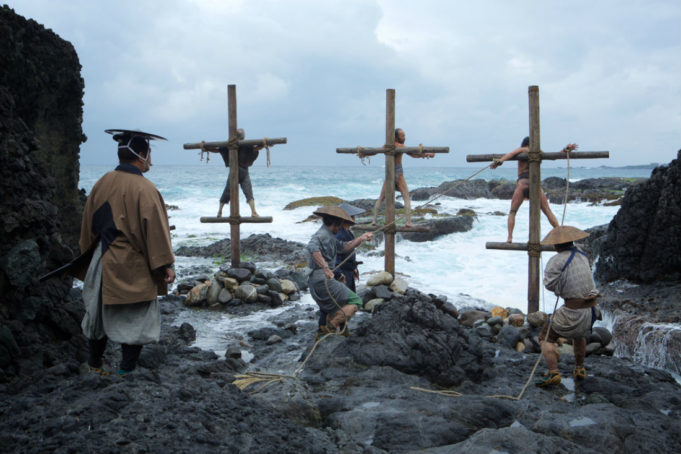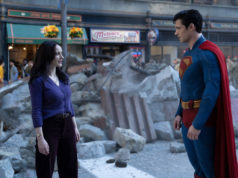My other duties at the Weekly kept me from seeing Martin Scorsese’s Silence before I made out my list of the year’s best films. I was determined to see it and report to you on whether it would have dented my list. The short answer is “no,” and given that Scorsese waited decades to make this religious epic, you may take that verdict as disappointing.
Don’t do that, though. This is still a powerful film about faith, and along with Anne Fontaine’s Polish-French drama The Innocents and Pablo Larraín’s The Club, it forms a triptych of 2016 films that examine the nature of belilef in God and what it’s like to have it, maintain it, or lose it. All those movies are about Catholics. Someday, someone with a deeper religious background will have to explain to me why Catholics seem to make better films than their evangelical brethren. Maybe it’s because they’re more at home with doubt. True to the 1966 novel by Shūsaku Endō that this is based on (and much like Fontaine and Larraín), Scorsese never tells us where his flawed hero ultimately stands with God. This ambiguity would probably be anathema to, say, the makers of the God’s Not Dead films, but it’s the very stuff of art.
The movie begins with two Portuguese Jesuit priests named Rodrigues and Garrpe (Andrew Garfield and Adam Driver) being dispatched in 1640 to the area around Nagasaki to find the whereabouts of a priest named Ferreira (Liam Neeson). The Japanese emperor has spent the last few decades systematically persecuting the country’s Christians, and while Ferreira was once Rodrigues’ mentor and confessor, the rumors now have it that he has renounced the faith by publicly stepping on a fumi-e, a bronze plaque with a relief sculpture of Christ that’s made to be profaned. In addition to discovering what happened to Ferreira, the priests’ mission is to spread the Word and minister to Japan’s isolated underground Catholics.
The movie takes its title from the silence that Rodrigues hears from God as his followers are tortured and murdered by the emperor’s authorities. Rodrigues comes ready to die for his faith, but instead he’s forced to watch practically everyone else die for it. The priests watch from a hiding place as three of their main parishioners are lashed to crosses buried on a beach and left to be killed by the rising tide. (This is a visual motif that can be seen in other Scorsese films. The camera often films from behind trees or around corners to emphasize that the priests are being spied on, and that they’re often forced to hide in turn to watch things unfold.) The priest wonders how God can remain silent in the face of so much suffering, or indeed whether God exists at all and all these people are dying for nothing.
Rodrigues’ tormented relationship with his belief is the crux of this film. There are some deeply moving scenes early on depicting the Japanese Christians’ gratitude at having proper priests perform the sacraments for them and cleanse their souls. (One of the Christians is played by actor and horror/science-fiction movie director Shinya Tsukamoto.) Yet these are offset by his interactions with Kichijiro (Yôsuke Kubozuka), a contemptible drunk of a local guide who repeatedly sells out his fellow Christians to save himself, only to crawl back to Rodrigues and beg for forgiveness. He’s a test of Rodrigues’ faith even before the violence starts up in earnest.
Despite a silver-tongued interpreter (Tadanobu Asano) and his efforts to assure Rodrigues that renouncing his belief will be easy, Rodrigues’ faith isn’t shaken until he finally reunites with Ferreira. In a great scene late in the film, Neeson gives off the impression of a man who’s been broken inside, yet who’s nevertheless still strong enough to methodically dismantle the priest’s arrogant assumption that the God of Catholic Europe will conquer this pagan land. While other Christians are being hung upside-down in pits and slowly bled to death in front of them, Ferreira challenges Rodrigues to save their lives by stepping on his own fumi-e. As Rodrigues pleads for a moment to think, Ferreira tells him, “Pray. But pray with your eyes open.”
Rodrigues’ behavior after that scene will likely drive the post-movie argument. You’ll have your own take; for my part, I think his treatment of Kichijiro and his refusal to abandon him is the key to understanding where his heart lies. In any event, this is all couched in cinematographer Rodrigo Prieto’s luxuriating in the subtropical vegetation (Taiwanese locations stand in for pre-modern southern Japan) and direction that makes the film’s 161-minute running time feel light-footed and filled with incident despite its deliberate pace. This weekend, the movie starts playing at a few theaters in Tarrant County, and whatever your beliefs might be, it will make you think.
Silence
Starring Andrew Garfield, Adam Driver, and Liam Neeson. Directed by Martin Scorsese. Written by Jay Cocks and Martin Scorsese, based on Shūsaku Endō’s novel. Rated R.












